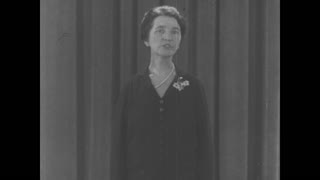Narrated by Katherine Hepburn and directed by Herman J. Engel, this documentary profile of Margaret Sanger was created by Planned Parenthood World Population in 1966, the 50th Anniversary year of the organization, and the year that Sanger passed. Margaret Sanger, also known as Margaret Sanger Slee, was an American birth control activist, sex educator, writer, and nurse. She popularized the term “birth control”, opened the first birth control clinic in the United States, and established organizations that evolved into the Planned Parenthood Federation of America. Sanger was prosecuted for her book Family Limitation under the Comstock Act in 1914. Eventually her efforts contributed to several judicial cases that helped legalize contraception in the United States. In 1916, Sanger opened the first birth control clinic in the U.S., which led to her arrest for distributing information on contraception, after an undercover policewoman bought a copy of her pamphlet on family planning. In 1921, Sanger founded the American Birth Control League, which later became the Planned Parenthood Federation of America. She is widely regarded as a founder of the modern birth control movement. (Note: Sanger drew a sharp distinction between birth control and abortion, and was opposed to abortions throughout the bulk of her professional career, declining to participate in them as a nurse.) (Note: Katherine Hepburn’s parents were a New England urologist who campaigned to educate the public about venereal disease and a suffragette who worked with Margaret Sanger to promote birth control.)
• 0:14: Margaret Sanger had to settle on being a nurse, which interrupted her career but not her development.
• 0:31: During this period, she became familiar with feminists, suffragists and the broader social reform movement shaping 20th-century America.
• 0:55: While her children were young, she decided to return to nursing.
• 1:11: She chose to work in the Lower East Side of New York City, a slum neighborhood.
• 1:24: She observed that the poor had more children than they could care for, which kept them in poverty.
• 1:42: She saw the burden of constant pregnancy and deaths from illegal abortions.
• 1:50: She decided to give up nursing and started the American birth control movement.
• 2:09: Her efforts angered Anthony Comstock, leading to her indictment and flight to Europe.
• 2:24: In Europe, she learned about birth control practices in France, Holland, and England. Images: crowded neighborhood in France or Belgium. 2:49 The Tower Bridge in London.
• 3:06: Upon returning, she opened America’s first birth control clinic, which was soon closed, and she was arrested.
• 3:30: She chose jail over recanting and emerged with a sense of moral triumph.
• 3:39: Women from across the country reached out to her for help. 3:57: POV shots from the rear of a moving train.
• 4:25: She traveled to organize Planned Parenthood clinics in response to these letters.
• 5:01: After World War I, she looked at the problem in a broader context and extended her travels to Asia.
• 6:11: She began work that led to the establishment of the International Planned Parenthood Federation.
• 6:26: She held the first International Conference on population planning despite opposition. Sanger makes a speech on camera.
• 7:04: Her views gradually prevailed, and by mid-20th century, fertility control became a major world issue.
8:05: Headline from a CBS News Report about the Population Explosion on Earth
• 9:16: The President of the United States Lyndon B Johnson addressed the multiplying problems of population growth.
• 10:01: Even the Catholic Church began reconsidering birth control.
• 10:27: Family planning suited to individual preferences increased dramatically. Shots of a family planning office aka Planned Parenthood. At 10:39, an African American woman learns about birth control options.
• 11:04: Despite advances, the need and desire for family planning remain urgent, especially in emerging nations. Images of various foreign countries with birth control clinics, and mothers with children, and then tribute photos of Sanger close the film.
If you have endangered films you’d like to have scanned, or wish to donate celluloid to Periscope Film so that we can share them with the world, we’d love to hear from you. Contact us via the weblink below.
This film is part of the Periscope Film LLC archive, one of the largest historic military, transportation, and aviation stock footage collections in the USA. Entirely film backed, this material is available for licensing in 24p HD, 2k and 4k. For more information visit http://www.PeriscopeFilm.com


